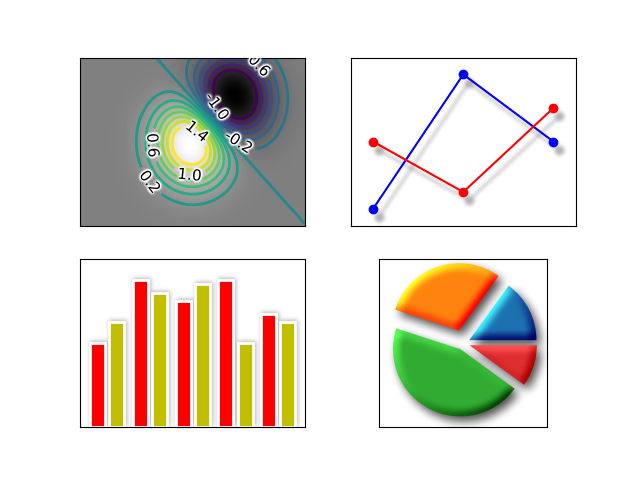Note
Go to the end to download the full example code.
AGG filter#
Most pixel-based backends in Matplotlib use Anti-Grain Geometry (AGG) for
rendering. You can modify the rendering of Artists by applying a filter via
Artist.set_agg_filter.

import matplotlib.pyplot as plt
import numpy as np
from matplotlib.artist import Artist
import matplotlib.cm as cm
from matplotlib.colors import LightSource
import matplotlib.transforms as mtransforms
def smooth1d(x, window_len):
# copied from https://scipy-cookbook.readthedocs.io/items/SignalSmooth.html
s = np.r_[2*x[0] - x[window_len:1:-1], x, 2*x[-1] - x[-1:-window_len:-1]]
w = np.hanning(window_len)
y = np.convolve(w/w.sum(), s, mode='same')
return y[window_len-1:-window_len+1]
def smooth2d(A, sigma=3):
window_len = max(int(sigma), 3) * 2 + 1
A = np.apply_along_axis(smooth1d, 0, A, window_len)
A = np.apply_along_axis(smooth1d, 1, A, window_len)
return A
class BaseFilter:
def get_pad(self, dpi):
return 0
def process_image(self, padded_src, dpi):
raise NotImplementedError("Should be overridden by subclasses")
def __call__(self, im, dpi):
pad = self.get_pad(dpi)
padded_src = np.pad(im, [(pad, pad), (pad, pad), (0, 0)], "constant")
tgt_image = self.process_image(padded_src, dpi)
return tgt_image, -pad, -pad
class OffsetFilter(BaseFilter):
def __init__(self, offsets=(0, 0)):
self.offsets = offsets
def get_pad(self, dpi):
return int(max(self.offsets) / 72 * dpi)
def process_image(self, padded_src, dpi):
ox, oy = self.offsets
a1 = np.roll(padded_src, int(ox / 72 * dpi), axis=1)
a2 = np.roll(a1, -int(oy / 72 * dpi), axis=0)
return a2
class GaussianFilter(BaseFilter):
"""Simple Gaussian filter."""
def __init__(self, sigma, alpha=0.5, color=(0, 0, 0)):
self.sigma = sigma
self.alpha = alpha
self.color = color
def get_pad(self, dpi):
return int(self.sigma*3 / 72 * dpi)
def process_image(self, padded_src, dpi):
tgt_image = np.empty_like(padded_src)
tgt_image[:, :, :3] = self.color
tgt_image[:, :, 3] = smooth2d(padded_src[:, :, 3] * self.alpha,
self.sigma / 72 * dpi)
return tgt_image
class DropShadowFilter(BaseFilter):
def __init__(self, sigma, alpha=0.3, color=(0, 0, 0), offsets=(0, 0)):
self.gauss_filter = GaussianFilter(sigma, alpha, color)
self.offset_filter = OffsetFilter(offsets)
def get_pad(self, dpi):
return max(self.gauss_filter.get_pad(dpi),
self.offset_filter.get_pad(dpi))
def process_image(self, padded_src, dpi):
t1 = self.gauss_filter.process_image(padded_src, dpi)
t2 = self.offset_filter.process_image(t1, dpi)
return t2
class LightFilter(BaseFilter):
"""Apply LightSource filter"""
def __init__(self, sigma, fraction=1):
"""
Parameters
----------
sigma : float
sigma for gaussian filter
fraction: number, default: 1
Increases or decreases the contrast of the hillshade.
See `matplotlib.colors.LightSource`
"""
self.gauss_filter = GaussianFilter(sigma, alpha=1)
self.light_source = LightSource()
self.fraction = fraction
def get_pad(self, dpi):
return self.gauss_filter.get_pad(dpi)
def process_image(self, padded_src, dpi):
t1 = self.gauss_filter.process_image(padded_src, dpi)
elevation = t1[:, :, 3]
rgb = padded_src[:, :, :3]
alpha = padded_src[:, :, 3:]
rgb2 = self.light_source.shade_rgb(rgb, elevation,
fraction=self.fraction,
blend_mode="overlay")
return np.concatenate([rgb2, alpha], -1)
class GrowFilter(BaseFilter):
"""Enlarge the area."""
def __init__(self, pixels, color=(1, 1, 1)):
self.pixels = pixels
self.color = color
def __call__(self, im, dpi):
alpha = np.pad(im[..., 3], self.pixels, "constant")
alpha2 = np.clip(smooth2d(alpha, self.pixels / 72 * dpi) * 5, 0, 1)
new_im = np.empty((*alpha2.shape, 4))
new_im[:, :, :3] = self.color
new_im[:, :, 3] = alpha2
offsetx, offsety = -self.pixels, -self.pixels
return new_im, offsetx, offsety
class FilteredArtistList(Artist):
"""A simple container to filter multiple artists at once."""
def __init__(self, artist_list, filter):
super().__init__()
self._artist_list = artist_list
self._filter = filter
def draw(self, renderer):
renderer.start_rasterizing()
renderer.start_filter()
for a in self._artist_list:
a.draw(renderer)
renderer.stop_filter(self._filter)
renderer.stop_rasterizing()
def filtered_text(ax):
# mostly copied from contour_demo.py
# prepare image
delta = 0.025
x = np.arange(-3.0, 3.0, delta)
y = np.arange(-2.0, 2.0, delta)
X, Y = np.meshgrid(x, y)
Z1 = np.exp(-X**2 - Y**2)
Z2 = np.exp(-(X - 1)**2 - (Y - 1)**2)
Z = (Z1 - Z2) * 2
# draw
ax.imshow(Z, interpolation='bilinear', origin='lower',
cmap=cm.gray, extent=(-3, 3, -2, 2), aspect='auto')
levels = np.arange(-1.2, 1.6, 0.2)
CS = ax.contour(Z, levels,
origin='lower',
linewidths=2,
extent=(-3, 3, -2, 2))
# contour label
cl = ax.clabel(CS, levels[1::2], # label every second level
inline=True,
fmt='%1.1f',
fontsize=11)
# change clabel color to black
from matplotlib.patheffects import Normal
for t in cl:
t.set_color("k")
# to force TextPath (i.e., same font in all backends)
t.set_path_effects([Normal()])
# Add white glows to improve visibility of labels.
white_glows = FilteredArtistList(cl, GrowFilter(3))
ax.add_artist(white_glows)
white_glows.set_zorder(cl[0].get_zorder() - 0.1)
ax.xaxis.set_visible(False)
ax.yaxis.set_visible(False)
def drop_shadow_line(ax):
# copied from examples/misc/svg_filter_line.py
# draw lines
l1, = ax.plot([0.1, 0.5, 0.9], [0.1, 0.9, 0.5], "bo-")
l2, = ax.plot([0.1, 0.5, 0.9], [0.5, 0.2, 0.7], "ro-")
gauss = DropShadowFilter(4)
for l in [l1, l2]:
# draw shadows with same lines with slight offset.
xx = l.get_xdata()
yy = l.get_ydata()
shadow, = ax.plot(xx, yy)
shadow.update_from(l)
# offset transform
transform = mtransforms.offset_copy(l.get_transform(), ax.figure,
x=4.0, y=-6.0, units='points')
shadow.set_transform(transform)
# adjust zorder of the shadow lines so that it is drawn below the
# original lines
shadow.set_zorder(l.get_zorder() - 0.5)
shadow.set_agg_filter(gauss)
shadow.set_rasterized(True) # to support mixed-mode renderers
ax.set_xlim(0., 1.)
ax.set_ylim(0., 1.)
ax.xaxis.set_visible(False)
ax.yaxis.set_visible(False)
def drop_shadow_patches(ax):
# Copied from barchart_demo.py
N = 5
group1_means = [20, 35, 30, 35, 27]
ind = np.arange(N) # the x locations for the groups
width = 0.35 # the width of the bars
rects1 = ax.bar(ind, group1_means, width, color='r', ec="w", lw=2)
group2_means = [25, 32, 34, 20, 25]
rects2 = ax.bar(ind + width + 0.1, group2_means, width,
color='y', ec="w", lw=2)
drop = DropShadowFilter(5, offsets=(1, 1))
shadow = FilteredArtistList(rects1 + rects2, drop)
ax.add_artist(shadow)
shadow.set_zorder(rects1[0].get_zorder() - 0.1)
ax.set_ylim(0, 40)
ax.xaxis.set_visible(False)
ax.yaxis.set_visible(False)
def light_filter_pie(ax):
fracs = [15, 30, 45, 10]
explode = (0.1, 0.2, 0.1, 0.1)
pies = ax.pie(fracs, explode=explode)
light_filter = LightFilter(9)
for p in pies[0]:
p.set_agg_filter(light_filter)
p.set_rasterized(True) # to support mixed-mode renderers
p.set(ec="none",
lw=2)
gauss = DropShadowFilter(9, offsets=(3, -4), alpha=0.7)
shadow = FilteredArtistList(pies[0], gauss)
ax.add_artist(shadow)
shadow.set_zorder(pies[0][0].get_zorder() - 0.1)
if __name__ == "__main__":
fix, axs = plt.subplots(2, 2)
filtered_text(axs[0, 0])
drop_shadow_line(axs[0, 1])
drop_shadow_patches(axs[1, 0])
light_filter_pie(axs[1, 1])
axs[1, 1].set_frame_on(True)
plt.show()
Total running time of the script: (0 minutes 1.344 seconds)